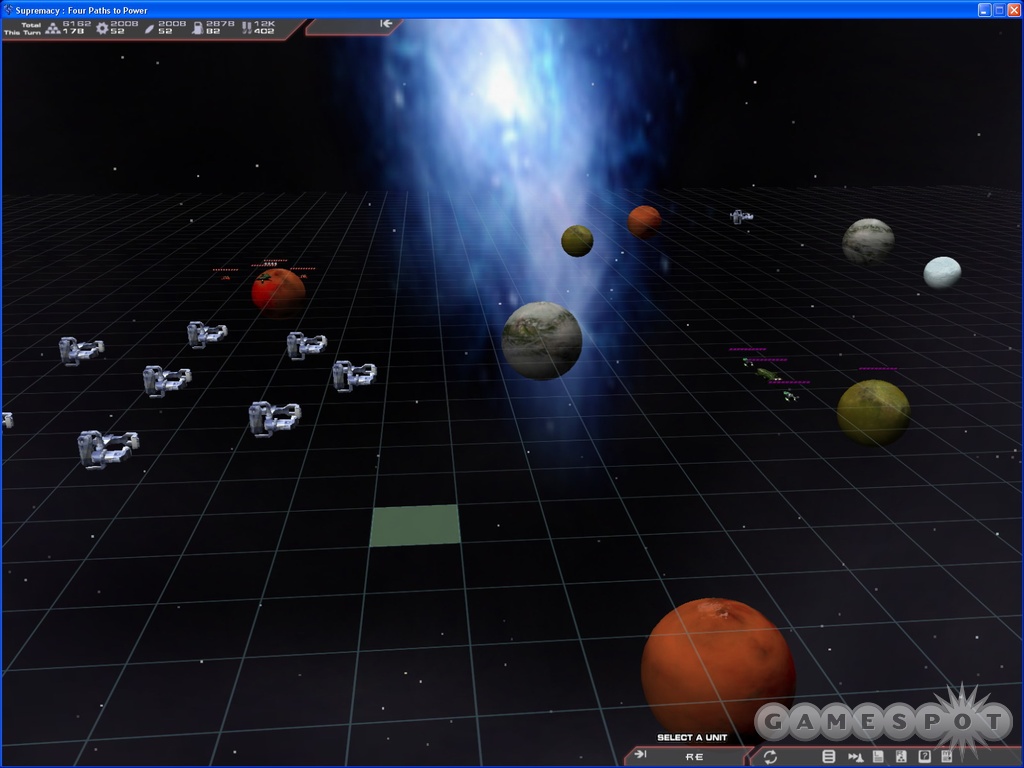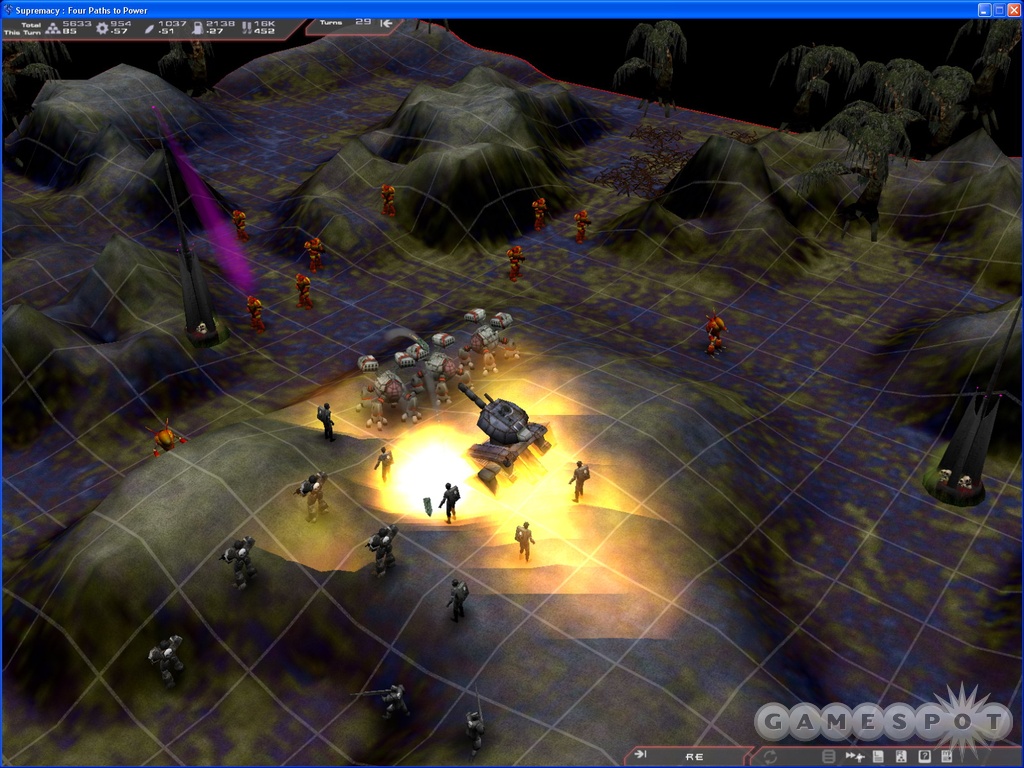Supremacy: Four Paths to Power is a space exploration and conquest game that looks so simple and elegant at first glance that you'd almost think it would work as a board game design. The gameplay ultimately is a little deeper than that, but this is still a low-complexity game that's easy to learn and, unfortunately, very easy to master.

Play begins by selecting a commander, who provides certain bonuses throughout the game, and by selecting from one of the many game types, which vary from pure conquest to competitive rescue missions. Maps in most game modes tend to be symmetrical, with plenty of planets and neutral space stations on either side that can be captured to provide resources and technology improvements. But after an initial buildup phase, players inevitably must leave the confines of their sides of the map to start whittling away at the opponent's territory.
Most of the gameplay takes place on a nice-looking 3D space map, where amassed fleets blast one another while science vessels scout around. But that all changes when planets are assaulted by ground troops. Then the game switches to a 3D terrain map based on the type of planet where the battle takes place, and ground troops slug it out. These planetary battles don't look nearly as good as the space maps, and although the entire game has a unified look and a decent interface, the special effects are weak, and the sound effects are generic.
Ground combat is turn-based and fairly simplistic, despite the wide variety of troop types available. Within a few seconds of looking at the type of army the opposition is fielding, it's immediately apparent whether or not you'll be able to win. After that, it's just a matter of going through the motions as you move troops, fire, and wait for the inevitable outcome. The scale also seems completely out of whack, as it seems absurd that a handful of troops are all that's necessary to capture an entire planet.
The diversity of the ground troops at last keeps things somewhat interesting, as many have special abilities determined by race. There are standard infantry, snipers, tanks, and other units, but the most effective armies incorporate specialized troops that can freeze, poison, heal, or otherwise bring unique abilities to the battlefield.
The way units are manufactured involves some of the best mechanisms in the game. The type of units available depends entirely on the planet where you make them. So if you need to round out your army or fleet with a "Pyro" flamethrower unit or a "K-7 Inferno" fighter, you'll need to conquer a fiery Cha'ar world first. If you conquer at least one of each type of world, you can start cranking out massive battle cruisers. And if you further manage to take over every planet of a single type on the map, you can manufacture that race's mothership, which is the most powerful and strategically important unit in the game.
Ships are created immediately, as long as you have the proper resources. However, ground troops work a little differently. Each planet starts out with four factories, which in turn create a grid of manufacturing slots. The more factories you have, the more slots are available, although upgrading to five or six factories adds a chance that there will be a planetary meltdown, destroying a very valuable resource.
The manufacturing slots are critical because each unit created consumes a fixed number of slots. Generic infantry takes up one slot each, so you can crank out up to 20 of them per turn with just four factories. Tanks, on the other hand, take up a nine-slot square, so there's only room for one of them in the five-by-four four-factory grid. Snipers use two vertical slots, artillery troops require a block of four slots, and specialized troops, like flamethrower units, take up two horizontal slots. So planning what you want to build and the order you need to build it in is somewhat like assembling a puzzle each turn. The largest ground units take up more space than four factories can provide, so you'll need to add additional factories--and assume the risk involved with doing so--if you want to play with the big toys.
The same slot system is in play when ground units are loaded onto transport ships, greatly reducing the number and types of troops available on any particular strike. This makes it possible to use swarm tactics by packing a transport with numerous generic infantry units or opting for a combined-arms assault that only involves a few large units backed by some specialized troops, with a few infantry units sprinkled in to fill any remaining gaps.
Although the mechanisms all seem straightforward, keeping track of everything isn't always easy. A budget window puts a handy overview of all input, output, and upkeep all in one convenient place. But it tells only a portion of the story. Resources are consumed every time a ship moves, a special weapon fires, or any number of other actions are taken. Therefore it's up to the player to coordinate exploration, acquisition, and attacks so enough resources are available to do everything. Few things are worse than maneuvering a fleet into attack position only to discover it doesn't have enough resources to attack or moving a transport all the way to a critical planet to find out that your units are stuck on the ship while you must try to scrounge up enough resources to carry out your attack. Micromanagers will love this, but it adds a lot of tedious number crunching to what could otherwise be a fairly enjoyable lightweight game.

The real killer here, however, is an artificial intelligence that simply can't put up a decent fight. There's no fog of war to worry about, so players always know what the computer is up to, and so it's easy to gain a huge production advantage early on to more easily crush the AI. Battle cruisers can carry fully laden troop transports through even the most heavily defended enemy areas, making it fairly easy to take crucial objectives. Neutral pirates sometimes pop up to become nuisances for both sides, but the enemy tends to throw everything it has against these minor threats, leaving its territory wide open for attack. There are many subtleties and unit combinations available for those who want to take a more strategic approach to victory, but using them against the AI is like building a convoluted Rube Goldberg contraption to kill a fly, when all you really need to do is swat it. Two-player hotseat, LAN, and Internet matches are supported, and facing off against a human is the only way to squeeze any long-term enjoyment from this game.



